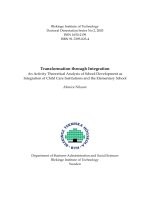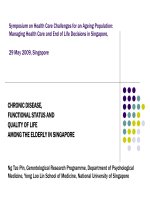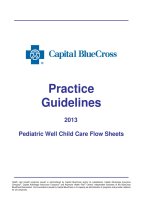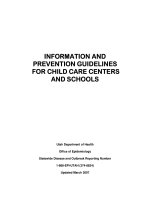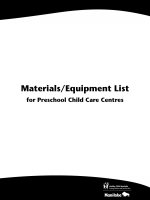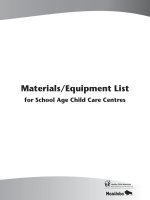Child care centre and home exposures among preschool children in singapore and their associations with asthma, allergies and respiratory symptoms
Bạn đang xem bản rút gọn của tài liệu. Xem và tải ngay bản đầy đủ của tài liệu tại đây (2.8 MB, 340 trang )
CHILD CARE CENTRE AND HOME EXPOSURES AMONG
PRESCHOOL CHILDREN IN SINGAPORE AND THEIR
ASSOCIATIONS WITH ASTHMA, ALLERGIES AND
RESPIRATORY SYMPTOMS
Z
URAIMI BIN MOHAMED SULTAN
NATIONAL UNIVERSITY OF SINGAPORE
2008
CHILD CARE CENTRE AND HOME EXPOSURES AMONG
PRESCHOOL CHILDREN IN SINGAPORE AND THEIR
ASSOCIATIONS WITH ASTHMA, ALLERGIES AND
RESPIRATORY SYMPTOMS
Z
URAIMI BIN MOHAMED SULTAN
B.Sc., (Chem & Mat Sci), NUS
M.Bldg.Sc., NUS
A THESIS SUBMITTED
FOR THE DEGREE OF DOCTOR OF PHILOSOPHY
DEPARTMENT OF BUILDING
NATIONAL UNIVERSITY OF SINGAPORE
2008
_____________________________________________________________________________________________
i
ACKNOWLEDGEMENTS
I would like to thank Profs Cheong Hin Fatt and George Ofori for allowing me to pursue this work in the
Department of Building and Mrs Elias Ismail from the Ministry of Community, Youth and Sports for the
support, assistance and encouragement in soliciting the participation of the child care centers in this
project. Special thanks are reserved for my supervisor A/Prof Tham Kwok Wai for the guidance and
support in this research.
There are many people that helped me throughout the course of this work; Prof David Koh in matters
relating medical epidemiology and manuscript drafting; Dr Gerald Koh who provided advice relating
asthma and allergies from a clinician’s point of view; Dr Chew Fook Tim who assisted, guided and
advised in matters relating to allergen measurements and asthma epidemiology; Dr Ong Tan Ching who
assisted in the allergen analyses; A/Prof Ooi Peng Lim who assisted in the questionnaire development and
epidemiological analyses; Prof Claude-Alain Roulet in providing the TGD software and advice in
ventilation measurements; A/Prof Chan Yiong Huak in biostatistical analyses. Profs Jan Sundell and Carl-
Gustaf Bornehag in advice relating to the study design and Dr Linda Hagerhed-Engman in support,
information sharing and advice in research design and analyses. Thank you all very much.
I am indebted to my sampling and data-entry team comprising of students from National University of
Singapore, Singapore Polytechnic and Nanyang Polytechnic; Loh Ting Tuan, Tan Su Shan; Lin Su Qing;
Moshood Fadeyi, Adeline Phang, Khairulizwan, Guo Dian Yang, Teresa Lim, Low Ming Fui and Tan
Mei Xi.
I acknowledge the tremendous help of the participating child care center principals, licensees, teachers,
maintenance workers and parents of children. Without them, this work will not have been successful.
I also wish to express my sincere appreciation and gratitude to everyone who, in one way or another, have
contributed to the successful completion of this thesis.
Special acknowledgement is reserved for my family; for their love, understanding, support and patience
facing long hours away from me throughout the course of this work.
Above all, I thank the Almighty God.
_____________________________________________________________________________________________
ii
TABLE OF CONTENTS
Acknowldegments …………………………………………………………………… i
Table of Contents ………………………………………………………………………ii
Summary ……………………………………………………………………………… x
List of Tables………………………………………………………………………… xii
List of Figures ………………………………………………………………………….xvii
List of Symbols ……………………………………………………………………… xx
List of Publications Arising out of Thesis …………………………………………… xxii
1 Introduction 1
1.1 Background 1
1.2 Asthma, Allergies and Respiratory Infections 2
1.2.1 Asthma and Allergies 2
1.2.2 Respiratory Infections 3
1.2.3 Worldwide Trends and Current Hypotheses 4
1.3 Indoor Air: Exposures and Risk Factors 6
1.3.1 Dampness 6
1.3.2 Chemicals 6
1.3.2.1 Environmental Tobacco Smoke (ETS) 6
1.3.2.2 Building Materials and Finishes Emissions 7
1.3.2.3 Outdoor Traffic Emissions 8
1.3.3 Home or CCC Indoor Risk Factors? 8
1.3.4 Indoor Air Quality in CCCs 9
1.3.5 Indoor Allergens in CCCs 10
1.4 Knowledge Gap Identification 11
1.4.1 Home Indoor Exposures as Risk Factors 11
1.4.2 Traffic Exposure Indoors and Air Conditioning (AC) 12
1.4.3 CCC Indoor Risk Factors 12
1.4.4 IAQ and Ventilation Determinants in CCC 13
1.4.5 Indoor Allergens in CCCs 13
1.5 Objectives 14
1.6 General Research Methodology 15
1.6.1 Overview of Sampling Design 15
_____________________________________________________________________________________________
iii
1.6.2 Conceptual Framework Models 17
1.6.2.1 Linking Indoor Air Quality, Exposure, Ventilation and Health 17
1.6.2.2 Linking Exposure, Health and Confounders 18
1.7 Thesis Outline & Research Program 22
1.7.1 Thesis Outline 22
1.7.2 Thesis vis-à-vis Backdrop of Research Program 23
2 Indoor Air Quality of CCCs and the Effects of Ventilation Strategies 25
2.1 Introduction 25
2.1.1 Literature Review on CCC Indoor Air Quality (IAQ) 26
2.1.1.1 Physical Characterization 26
2.1.1.2 Chemical Characterization 27
2.1.1.3 Biological Characterization 29
2.1.2 Summary of Literature Review vis-à-vis Tropical Conditions in Singapore –
Knowledge Gap Identification 30
2.1.3 Ventilation Strategies as an Important Determinant of IAQ in CCCs 31
2.1.4 Objectives 31
2.2 Materials and Methods 32
2.2.1 CCC Population and Sampling. 32
2.2.1.1 Temperature, Relative Humidity and Air Velocity 33
2.2.1.2 Carbon Dioxide, Carbon Monoxide and Ventilation Rates 33
2.2.1.3 Fine Particle (PM2.5) and Ozone 34
2.2.1.4 Airborne Viable Bacteria and Fungi 35
2.2.1.5 Volatile Organic Compounds (VOCs) and Carbonyls 35
2.2.1.6 CCC Characteristics 37
2.2.2 Data analysis 38
2.3 Results. 39
2.3.1 Baseline Data 39
2.3.1.1 Temperature, Relative Humidity, Air Velocity and Ventilation Parameters . 39
2.3.1.2 CO2, CO, PM2.5 and O3 39
2.3.1.3 Bacteria and Fungi 40
2.3.1.4 Volatile Organic Compounds and Carbonyls 40
2.3.2 Effects of Ventilation Strategies 46
2.3.2.1 Stratified CCC Characteristics 46
_____________________________________________________________________________________________
iv
2.3.2.2 Temperature, Relative Humidity, Air Velocity and Ventilation Parameters . 46
2.3.2.3 CO2, CO, PM2.5 and O3 50
2.3.2.4 Bacteria and Fungi 53
2.3.2.5 Volatile Organic Compounds and Carbonyls 57
2.4 Discussion. 66
2.4.1 Baseline Data 66
2.4.2 Effect of Ventilation Strategies 68
2.4.3 Strengths, Limitations and Considerations 72
2.5 Conclusion 73
3 Indoor Allergens in CCCs: Concentrations, Distribution and Determinants 75
3.1 Introduction 75
3.1.1 Literature Review on CCC Indoor Allergens 75
3.1.2 Literature Review on Distributions of Indoor Allergens in CCC 77
3.1.3 Literature Review on Determinants of Indoor Allergens 78
3.1.4 Summary and Identification of Knowledge Gap 80
3.1.5 Objectives 82
3.2 Materials and Methods 82
3.2.1 CCC Population and Sampling 82
3.2.2 Dust Collection Procedures 82
3.2.3 Allergen Extraction 83
3.2.4 Allergen Analysis 83
3.2.4.1 Bead Coupling and Activation 84
3.2.4.2 Bioplex Assays (Der p 1, Fel d 1, Bla g 1, Can f 1, Mus m 1) 85
3.2.4.3 ELISA Assay (Asp f 1, Blo t 5) 85
3.2.5 CCC Characteristics and Indoor Air Quality 86
3.2.6 Data Analysis 86
3.3 Results 87
3.3.1 Summary statistics 87
3.3.2 Concentrations of Allergens in Different Niches 88
3.3.3 Characteristics and Indoor Air Quality of CCCs 95
3.3.4 Bivariate Associations between IAQ in CCCs and Allergens 96
3.3.5 Bivariate Associations between CCC Characteristics and Allergens 97
_____________________________________________________________________________________________
v
3.3.6 Multivariate Associations between CCC Characteristics and IAQ with Allergens Levels
……………………………………………………………………………………… 97
3.4 Discussion 102
3.4.1 Baseline Data, Comparison and Distributions 102
3.4.2 Associations of Allergens with CCC Characteristics and IAQ 103
3.5 Conclusion 108
4 On the Associations of CCC Characteristics with Asthma, Allergies and Respiratory
Symptoms …………………………………………………………………………………109
4.1 Introduction & Literature Review 109
4.1.1 Health of Children Associated with CCCs Attendance 109
4.1.2 Review Process for Studies on CCC Characteristics Associations with Health 112
4.1.3 Ventilation Strategies and Health 113
4.1.4 Ventilation and Respiratory Symptoms 114
4.1.5 Associations of CCC Dampness with Asthma, Allergies and Respiratory Symptoms
……………………………………………………………………………………….115
4.1.6 Associations of CCC Building Materials with Asthma, Allergies and Respiratory Symptoms
116
4.1.7 Associations of CCC Cleaning and Maintenance with Asthma, Allergies and Respiratory
Symptoms 117
4.1.8 Associations of Outdoor Pollution Sources of CCC with Asthma, Allergies and Respiratory
Symptoms 117
4.1.9 Summary of Literature Review and and Knowledge Gap Identification 117
4.2 Objective 119
4.3 Methods and Materials 120
4.3.1 CCC Characteristics – Exposure Variables 120
4.3.2 Questionnaire Survey 120
4.3.3 Statistical Analyses 122
4.4 Results 124
4.4.1 Prevalence of Symptoms by CCC Exposures 124
4.4.2 Prevalence Ratio - Ventilation Strategies 143
4.4.3 Prevalence Ratio - Dampness 143
4.4.4 Prevalence Ratio - Building Materials 146
_____________________________________________________________________________________________
vi
4.4.5 Prevalence Ratio - Cleaning Frequency and Maintenance 151
4.4.6 Prevalence Ratio - Outdoor Pollution 154
4.5 Discussion 157
4.5.1 Prevalence of Symptoms 157
4.5.2 Ventilation Strategies 157
4.5.2.1 Rhinitis, Eczema and Flexural Rash 158
4.5.2.2 Respiratory Symptoms 159
4.5.2.3 Hybrid Ventilation and Respiratory Symptoms 160
4.5.3 Dampness and Molds 161
4.5.4 Building Materials, Cleaning Frequencies and Outdoor Pollution 162
4.5.4.1 Wall Wood Panels and Respiratory Symptoms 162
4.5.4.2 Recent Painting in CCCs and Chronic Cough 165
4.5.4.3 Plastic Tiles and Blinds 166
4.5.4.4 Traffic and Outdoor Pollution Sources 167
4.5.4.5 CCC Cleaning Frequencies 168
4.5.5 Strengths and Limitations 169
4.6 Conclusions 170
5 Home Indoor Risk Factors and Asthma and Allergies in Preschool Children 172
5.1 Introduction 172
5.2 Literature Review 172
5.2.1 Home Dampness/Molds and Children’s Asthma and Allergies 172
5.2.2 Home ETS exposure and Children’s Asthma and Allergies 174
5.2.3 Home Building Materials and Children’s Asthma and Allergies 175
5.2.4 Indoor Combustion Sources and Children’s Asthma and Allergies 177
5.2.5 Pet Exposures and Children’s Asthma and Allergies 178
5.2.6 Home Air Conditioning 178
5.2.7 Summary and Knowledge Gap Identification 179
5.3 Objectives 180
5.4 Methods and Materials 187
5.4.1 Cross-sectional Design 187
5.4.2 Questionnaire Survey – Health Endpoints 187
5.4.3 Questionnaire survey – Home Exposure Information 188
5.4.3.1 Dampness 188
_____________________________________________________________________________________________
vii
5.4.3.2 ETS 189
5.4.3.3 Floor and Wall Coverings 189
5.4.3.4 Painting and Renovation 189
5.4.3.5 Pet Keeping 190
5.4.3.6 Cooking Fuel 190
5.4.3.7 Air Conditioning 190
5.4.4 Statistical Analysis 190
5.4.5 Partial Validation Studies 191
5.5 Results 192
5.5.1 Dampness 192
5.5.2 ETS 197
5.5.3 Floor and Wall Coverings 202
5.5.4 Renovation and Painting 202
5.5.5 Pet Keeping 208
5.5.6 Cooking Fuel 208
5.5.7 Air Conditioning 208
5.5.8 Partial Validation 208
5.6 Discussion 216
5.6.1 General 216
5.6.2 Home Dampness as a Risk Factor 216
5.6.3 Home ETS as a Risk Factor 218
5.6.4 Home Wall Paper as a Risk Factor 220
5.6.5 Other Factors 221
5.6.6 Home Risk Factors versus CCC Risk Factors 222
5.6.7 Limitations of Study 223
5.7 Conclusions 223
6 Home Air-conditioning, Traffic Exposure and Asthma and Allergies in Preschool Children
…………………………………………………………………………………………… 224
6.1 Literature Review 224
6.1.1 Background 224
6.1.2 Asthma and Allergies and Traffic Exposures 224
6.1.3 Traffic-Related Exposures, Indoor Environments and Air-Conditioning 225
6.1.4 The Singapore Context and Identification of Knowledge Gap 227
_____________________________________________________________________________________________
viii
6.2 Objectives 228
6.3 Methods 228
6.3.1 Questionnaires 228
6.3.1 Partial Validation Studies 230
6.4 Results 230
6.5 Discusssion 239
6.6 Conclusions 242
7 Final Remarks 243
7.1 Conclusion 243
7.2 Review and Achievement of Objectives and Findings 243
7.2.1 First Objective 243
7.2.2 Second Objective 244
7.2.3 Third Objective 245
7.2.4 Fourth Objective 246
7.2.5 Fifth Objective 247
7.3 Implications and Recommendations 248
References 252
A Appendix Indoor Air Quality (IAQ) 291
A.1 Comparability of Instruments and Techniques– Results of Collocated Measurements 291
A.1.1 Instruments Measuring Carbon Dioxide (CO2) 291
A.1.2 Instruments Measuring Carbon Monoxide (CO) 292
A.1.3 Instruments Measuring Fine Particles (PM
2.5
) 292
A.1.4 Instruments Measuring Ozone (O
3
) 293
A.1.5 Air Exchange Rates Measurements Using CO
2
and SF
6
as Tracer Gases 293
A.2 Detection Limits of Measurements 294
A.2.1 Bacteria and Fungi 294
A.2.2 VOCs and Carbonyls 294
A.2.3 Allergens 294
A.3 Paired Measurements 296
A.3.1 Bacteria and Fungi 296
A.3.2 VOCs and Carbonyls 296
_____________________________________________________________________________________________
ix
A.4 Equipments and Software Used 297
B Appendix Child Care Center Building Inspection Sheet 303
C Appendix Parents Administered Questionnaire 307
D Appendix Home Inspection Sheet 314
_____________________________________________________________________________________________
x
SUMMARY
There are very few systematic studies on indoor air quality (IAQ) in homes and child care centers (CCCs)
in the tropical climate, and how they affect preschool children’s health. The purpose of this research is to
study the associations of asthma, allergies and respiratory symptoms among preschool children with the
home and CCC environments in the Tropics, as well as to evaluate their exposures to pollutants and
allergens in CCCs.
In a cross-sectional study involving 104 randomly selected CCCs in Singapore, measurements were
performed for a cohesive set of pollutants across a range of physical, chemical and biological parameters
representing those of indoor and/or outdoor sources. It was found that the ventilation strategies adopted
by CCCs in Singapore created differences in IAQ and thermal comfort parameters. Ventilation rates were
significantly higher in naturally ventilated and hybrid ventilated CCCs resulting in higher dilution of
indoor generated pollutants but also higher ingress of outdoor pollutants via higher ventilation and
pollutant penetration efficiencies. In air-conditioned and ACMV (air-conditioned and mechanically
ventilated) CCCs, the lower ventilation rates resulted in the increase in the concentration levels of indoor
generated pollutants but lower ingress of outdoor pollutants. Indoor allergen levels in CCCs were
generally low where dominant allergens (Der p 1, Blo t 5 and Fel d 1) from classroom floors, curtains and
mattresses showed statistical correlation but no difference between their levels. CCCs temperatures,
ventilation, cat owners and carpets were predictors for allergen levels.
This study found that children attending naturally ventilated CCCs have lower prevalence of most asthma
and allergy, and respiratory symptoms. The risk of current rhinitis among children was significantly
higher if they attend ACMV CCCs (PR 1.48; 95% CI:1.03-2.22) compared with naturally ventilated
CCCs. This risk remains significant after controlling for the influence of dust mite allergens. Air-
conditioned and moldy CCCs were also significantly associated with higher prevalence of respiratory but
not asthma and allergic symptoms. The use of wooden panels and recent painting in CCCs were
associated with increased risks of chronic cough symptoms among attending children. For the home
environment, exposure to dampness, environmental tobacco smoke (ETS) and wall-papers were
significantly associated with increased risks of asthma and/or allergic symptoms among preschool
children. Further, dose-response significant relationships between traffic densities and asthma and rhinitis
symptoms among children without any known indoor risk factors were found. Children sleeping in non-
air conditioned homes were found to have stronger associations between asthma and rhinitis symptoms
with traffic densities compared to those sleeping in air conditioned homes. Comparing the categories of
_____________________________________________________________________________________________
xi
‘heavy’, and ‘medium’ with ‘low’ traffic densities exposure, the respective adjusted PRs (95% CIs) for
wheeze were 1.13 (0.66-1.94) and 2.06 (0.97-4.38); for doctor-diagnosed asthma 1.36 (0.64-2.88) and
2.89 (1.14-7.32); for rhinitis 1.30 (0.86-1.82) and 1.73 (1.00-2.99) and for rhinoconjunctivitis 1.58 (0.70-
3.59) and 3.39 (1.24-9.27).
In conclusion, this thesis provides new information for the creation of healthy indoor environments in
CCCs and homes in the tropics for preschool children.
KEYWORDS
Indoor Air Quality (IAQ); Child Care Centers (CCCs); Homes; Preschool Children; Asthma and Allergies;
Respiratory Symptoms; Exposures; Epidemiology; Cross-Sectional.
_____________________________________________________________________________________________
xii
LIST OF TABLES
Table 2.1: Summary statistics of temperature, relative humidity, air velocity and ventilation parameters
of the 104 CCCs 42
Table 2.2: Summary statistics of carbon dioxide, carbon monoxide, fine particles and ozone of the 104
CCCs 42
Table 2.3: Summary statistics of of viable bacteria and fungi of the 104 CCCs 43
Table 2.4: Summary statistics of volatile organic compounds and carbonyls (μg/m
3
) 44
Table 2.5: Description of the 104 CCCs categorized by their ventilation strategies 47
Table 2.6: Mean environmental and IAQ parameters measured for the CCCs grouped 47
Table 2.7: Factor analysis for indoor concentrations of VOCs and carbonyls using PCA and MLS 58
Table 2.8: Concentrations of VOCs and carbonyls in CCCs with different ventilation strategies 62
Table 2.9: Comparison of some IAQ parameters for this study and published reports elsewhere 69
Table 3.1: Protein samples (antibody) used for various allergens 84
Table 3.2: Amounts of coating, standards and antibodies used for analysis 85
Table 3.3: Summary statistics of allergen concentrations from all dust samples collected (N=416) 87
Table 3.4: Geometric mean concentrations of allergens found in different niches. 91
Table 3.5a: Correlation table between Der p 1 levels in various niches 92
Table 3.5b: Correlation table between Blo t 5 levels in various niches 92
Table 3.5c: Correlation table between Fel d 1 levels in various niches 93
Table 3.5d: Correlation table between Can f 1 levels in various niches 93
Table 3.5e: Correlation table between Mus m 1 levels in various niches 94
Table 3.5f: Correlation table between Bla g 1 levels in various niches 94
Table 3.5g: Correlation table between Asp f 1 levels in various niches 95
Table 3.6: CCC characteristics (N = 104) 96
Table 3.7: Bivariate associations of CCC characteristics with allergens concentrations 100
Table 3.8: Residual analyses of multivariate regressions relating indoor temperature and log-transformed
Der p 1 concentration (A), air exchange rates and log transformed Blo t 5 concentration (B),
and percentage of cat owners and log-transformed Fel d 1 concentration (C) 102
Table 3.9: Comparison of some indoor allergens measured for this study and studies elsewhere 104
Table 4.1: Upper and lower respiratory illness and asthma, asthma and allergy related symptoms
among children associated with child care attendance 111
Table 4.2: Health outcomes of study and their definitions 121
Table 4.3a: Personal and home characteristics of the children 126
_____________________________________________________________________________________________
xiii
Table 4.3b: Number and prevalence of the 97 CCCs with different characteristics 127
Table 4.4: Number and prevalence of asthma, allergies and respiratory symptoms among children
according to CCC ventilation strategies 130
Table 4.5: Number and prevalence of asthma, allergies and respiratory symptoms among children
according to CCC dampness variable 131
Table 4.6: Number and prevalence of asthma, allergies and respiratory symptoms among children
according to CCC wall types 132
Table 4.7: Number and prevalence of asthma, allergies and respiratory symptoms among children
according to CCC flooring types 133
Table 4.8: Number and prevalence of asthma, allergies and respiratory symptoms among children
according to CCC ceiling types 134
Table 4.9: Number and prevalence of asthma, allergies and respiratory symptoms among children
according to CCC curtain types 135
Table 4.10: Number and prevalence of asthma, allergies and respiratory symptoms among children
according to recent painting and renovation 136
Table 4.11: Number and prevalence of asthma, allergies and respiratory symptoms among
children according to CCC shelf types 137
Table 4.12: Number and prevalence of asthma, allergies and respiratory symptoms among children
according to CCC floor and shelf cleaning frequency 138
Table 4.13: Number and prevalence of asthma, allergies and respiratory symptoms among children
according to CCC curtain and toilet cleaning frequency 139
Table 4.14: Number and prevalence of asthma, allergies and respiratory symptoms among children
according to CCC toys and mattress cleaning frequency 140
Table 4.15: Number and prevalence of asthma, allergies and respiratory symptoms
among children according to CCC traffic type and density. 141
Table 4.16: Number and prevalence of asthma, allergies and respiratory symptoms among children
according to outdoor CCC pollution. 142
Table 4.17: Adjusted prevalence ratios of asthma and allergies and respiratory symptoms among children
according to CCC ventilation strategies 144
Table 4.18: Adjusted prevalence ratios of asthma and allergies and respiratory symptoms among children
according to CCC dampness variables 145
Table 4.19: Adjusted prevalence ratios of asthma and allergies and respiratory symptoms among children
according to CCC wall types 146
Table 4.20: Adjusted prevalence ratios of asthma and allergies and respiratory symptoms among children
_____________________________________________________________________________________________
xiv
according to CCC flooring types 147
Table 4.21: Adjusted prevalence ratios of asthma and allergies and respiratory symptoms among children
according to CCC ceiling types 148
Table 4.22: Adjusted prevalence ratios of asthma and allergies and respiratory symptoms among children
according to CCC curtain types 149
Table 4.23: Adjusted prevalence ratios of asthma and allergies and respiratory symptoms among children
according to CCC shelf types, recent painting and renovation 150
Table 4.24: Adjusted prevalence ratios of asthma and allergies and respiratory symptoms among children
according to CCC floor and shelf cleaning frequencies 151
Table 4.25: Adjusted prevalence ratios of asthma and allergies and respiratory symptoms among children
according to CCC curtain and toilet cleaning frequencies 152
Table 4.26: Adjusted prevalence ratios of asthma and allergies and respiratory symptoms among children
according to CCC toy and mattress cleaning frequencies 153
Table 4.27: Adjusted prevalence ratios of asthma and allergies and respiratory symptoms among children
according to CCC traffic type 154
Table 4.28: Adjusted prevalence ratios of asthma and allergies and respiratory symptoms among children
according to CCC traffic density 155
Table 4.29: Adjusted prevalence ratios of asthma and allergies and respiratory symptoms among children
according to CCC outdoor pollution type 156
Table 4.30: Adjusted prevalence ratios of asthma and allergies among children according to CCC
ventilation strategies further adjusted for allergen parameters 158
Table 4.31: Specific lower respiratory illness associations with CCC dampness variables 162
Table 4.32: Wooden wall, measured formaldehyde and acetaldehyde exposures in CCCs and their relation
to chronic cough and phlegm 163
Table 4.33: VOCs and carbonyls in CCCs that with recent painting and no recent painting 166
Table 4.34: Prevalence of avoidance behavior to traffic sources in CCCs with health outcomes 168
Table 5.1a: Summary of reported associations between asthma and wheeze among old children with
various home indoor factors along with summary of key design features of studies reviewed
(see Table 5.3 for legend) 181
Table 5.1b: Summary of reported associations between asthma and wheeze among preschool children
with various home indoor factors along with summary of key design features of studies
reviewed (see Table 5.3 for legend) 183
_____________________________________________________________________________________________
xv
Table 5.2a: Summary of reported associations between rhinitis and eczema among old children with
various home indoor factors along with summary of key design features of studies reviewed
(see Table 5.3 for legend) 185
Table 5.2b: Summary of reported associations between rhinitis and eczema among preschool children
with various home indoor factors along with summary of key design features of studies
reviewed (see Figure 5.1 for legend) 186
Table 5.3: Legend used in Tables 5.1 and 5.2 187
Table 5.4: Health outcomes of study and their definitions 188
Table 5.5: Personal characteristics of the 4759 children 192
Table 5.6: Prevalence (%) of childhood asthma and allergies by damp stains, mold and dampness
exposed and reference groups 194
Table 5.7: Prevalence of asthma and allergies among children exposed to different number of rooms with
dampness 194
Table 5.8: Associations of childhood asthma and allergies with dampness variables by multiple Cox’s
proportional hazard regression. 195
Table 5.9: Prevalence (%) of childhood asthma and allergies by ETS variables exposed and reference
groups. 198
Table 5.10: Associations of childhood asthma and allergies with ETS by multiple Cox’s proportional
hazard regression 199
Table 5.11: Associations of childhood asthma with wall and floor coverings in 1 or more rooms. 203
Table 5.12: Associations of childhood allergies with wall and floor coverings in 1 or more rooms. 204
Table 5.13: Associations of childhood asthma and allergies with home renovation and painting 205
Table 5.14: Prevalence (%) of childhood asthma and allergies with pet variables 209
Table 5.15: Associations of childhood asthma and allergies with home pets variables 210
Table 5.16: Prevalence (%) of childhood asthma and allergies by cooking fuel variables. 211
Table 5.17: Associations of childhood asthma and allergies with cooking fuel variables by multiple Cox’s
proportional hazard regression. 212
Table 5.18: Prevalence (%) of childhood asthma and allergies by ventilation variables 213
Table 5.19: Associations of childhood asthma and allergies with ventilation variables by multiple Cox’s
proportional hazard regression 214
Table 5.20: Frequencies of exposure variables from inspections and questionnaires reports and their
agreement. 215
Table 5.21: Prevalence of dampness and mold in studies conducted elsewhere 217
_____________________________________________________________________________________________
xvi
Table 6.1: Distribution of personal characteristics, symptoms and exposures of preschool children by
ventilation strategies 232
Table 6.2: Adjusted prevalence ratios (PR) and 95% confidence intervals for asthma and allergic
symptoms according to traffic exposures 235
Table 6.3: Adjusted prevalence ratios (PR) and 95% confidence intervals for allergic and respiratory
symptoms according to traffic densities stratified by ventilation strategies 236
Table 6.4: Adjusted prevalence ratios (PR) and 95% confidence intervals for allergic and respiratory
symptoms according to resident height stratified by ventilation strategies 237
Table 6.5: Interaction effects of exposures to resident height and traffic density on asthma and allergic
symptoms 238
Table A.1: Method detection limits, linearity of calibration curves and precision estimates for VOCs and
carbonyls 295
Table A.2: Detection limits of allergens 295
_____________________________________________________________________________________________
xvii
LIST OF FIGURES
Figure 1.1: Number of children attending CCCs from 1990-2005 2
Figure 1.2: Sampling Design of the Thesis. 16
Figure 1.3: Conceptual model for linking building IAQ, ventilation, exposure and health. 18
Figure 1.4: Conceptual model of the relation between different postulated risk factors and asthma,
allergies and respiratory symptoms. 21
Figure 1.5: General structure of the research program and the thesis contribution 24
Figure 2.1: Locations of 104 participating CCCs in Singapore represented by the red dots 33
Figure 2.2: Air temperature classified under different ventilation strategies. 48
Figure 2.3: Relative humidity classified under different ventilation strategies 48
Figure 2.4: Air velocity classified under different ventilation strategies. 49
Figure 2.5: Ventilation parameters classified under different ventilation strategies. 49
Figure 2.6: Carbon dioxide concentrations under different ventilation strategies 51
Figure 2.7: Carbon monoxide concentrations under different ventilation strategies 51
Figure 2.8: PM
2.5
concentrations under different ventilation strategies. 52
Figure 2.9: Ozone concentrations under different ventilation strategies 52
Figure 2.10: CO, PM
2.5
and O
3
I/O ratios under different ventilation strategies. 53
Figure 2.11: Human-related bacteria concentrations for different ventilation strategies. 55
Figure 2.12: Environmental bacteria concentrations for different ventilation strategies. 55
Figure 2.13: Mesophilic fungi concentrations for different ventilation strategies 56
Figure 2.14: Xerophilic fungi concentrations for different ventilation strategies. 56
Figure 2.15: Indoor-Outdoor ratios of mesopilic and xerophilic fungi concentrations for CCCs with
Dampness/Mold under different ventilation strategies 57
Figure 2.16: Factor scores by ventilation strategies. 60
Figure 2.17a: Indoor-outdoor (I/O) ratios of compounds associated to BM factor 64
Figure 2.17b: Indoor-outdoor (I/O) ratios of compounds associated to AF/CP factor 64
Figure 2.17c: Indoor-outdoor (I/O) ratios of compounds associated to TE/IN factor 65
Figure 2.17d: Indoor-outdoor (I/O) ratios of compounds associated to WBP factor 65
Figure 2.17e: Indoor-outdoor (I/O) ratios of compounds associated to PWM factor 66
Figure 2.18: Regression intercepts of fungi stratified into dampness/mold status of CCCs 68
Figure 3.1: Distribution of allergen concentrations. (see Table 3.3 for corresponding units) 88
Figure 3.2a: Distributions of Der p 1 and Blo t 5 allergens in various niches 89
Figure 3.2b: Distributions of Fel d 1 and Can f 1 allergens in various niches 89
_____________________________________________________________________________________________
xviii
Figure 3.2c: Distributions of Mus m 1, Bla g 1 and Asp f 1 allergens in various niches 90
Figure 3.3: Bivariate associations between indoor temperatures, relative humidity and air change rates
with Der p 1 and Blo t 5 concentrations 98
Figure 3.4: Bivariate associations between prevalence of cat or dog owners in CCCs and air exchange
rates with Fel d 1 or Can f 1 concentrations 99
Figure 3.5: Residual plots of indoor temperature and log-transformed Der p 1 concentration (A), air
exchange rates and log transformed Blo t 5 concentration (B) and percentage of cat owners
and log-transformed Fel d 1 concentration (C) 101
Figure 3.6: Plots of indoor absolute humidity levels with mite allergens concentrations 105
Figure 3.7: Box plots of the diurnal variances of indoor temperature and relative humidity stratified into
air change rates quartiles. First quartile mean (N=30): 0.60h
-1
; Second quartile mean (N=31):
2.03 h
-1
; Third quartile mean (N=31): 3.75 h
-1
; Fourth quartile mean (N=31): 9.67 h
-1
106
Figure 4.1: Comparison of symptoms prevalence between two Singapore studies 5 years apart. 157
Figure 4.2: Indoor Concentrations and I-O Ratios of Formaldehyde for CCCs with Wooden Walls,
Ceilings and Flooring 164
Figure 4.3: Indoor Concentrations and I-O Ratios of Acetaldehyde for CCCs with Wooden Walls,
Ceilings and Flooring 164
Figure 4.4: Indoor benzene concentrations of CCCs stratified by traffic types and density 167
Figure 5.1: The adjusted prevalence ratios (PR) and their 95% confidence interval (CI) for asthma and
allergies among children in the categories of number of rooms with dampness. The boxes
represent the PR, and the horizontal bars indicate the 95 percent confidence intervals.
Multivariate regression analyses were performed using Cox proportional hazard model
adjusted for covariates similar to those in Table 5.8 196
Figure 5.2: The adjusted prevalence ratios (PR) and their 95% confidence interval (CI) for asthma and
allergies among children in the categories of number of cigarettes (cig) smoked in the homes
by fathers (A) and mothers (B). The boxes represent the PR, and the horizontal bars indicate
the 95 percent confidence intervals. Multivariate regression analyses were performed using
Cox proportional hazard model adjusted for covariates similar to those in Table 5.10 200
Figure 5.3: The adjusted prevalence ratios (PR) and their 95% confidence interval (CI) for asthma and
allergies among children in the categories of number of people who smoke in the homes. The
boxes represent the PR, and the horizontal bars indicate the 95 percent confidence intervals.
Multivariate regression analyses were performed using Cox proportional hazard model
adjusted for covariates similar to those in Table 5.10 201
_____________________________________________________________________________________________
xix
Figure 5.4: The adjusted prevalence ratios (PR) and their 95% confidence interval (CI) for asthma and
allergies among children in the categories of number of rooms that are painted in the past
year. The boxes represent the PR, and the vertical bars indicate the 95 percent confidence
intervals. Multivariate regression analyses were performed using Cox proportional hazard
model adjusted for covariates similar to those in Table 5.12 207
Figure 6.1: Box plots of PM
2.5
and BZN concentrations for self reported traffic densities 231
Figure A.1: Scatter plots of 3 Tel-Aire instruments measuring carbon dioxide (CO
2
) 291
Figure A.2: Scatter plots of 3 Tel-Aire instruments against Q-trak instrument measuring carbon dioxide 291
Figure A.3: Scatter plots of 3 T15v Langan CO Measurers measuring carbon monoxide (CO 292
Figure A.4: Scatter plots of PM
2.5
measuring equipments – Dustrak and MEM 292
Figure A.5: Scatter plots of ozone measuring equipments 293
Figure A.6: Scatter plots of air exchange rates (ACH) using SF6 and CO2 as tracer gas using decay
techniques. ACH utilizing CO2 as a tracer gas was computed using the TGD software
(Roulet & Foradini, 2002) 293
Figure A.7: QTrak and Tel-Aires interfaced with Hobos 297
Figure A.8: Langan CO Measurers. 297
Figure A.9: DustTraks and MEMs. 298
Figure A.10: 2B Tech Ozone Measuring Equipments. 298
Figure A.11: Andersen Samplers. 299
Figure A.12: VOC Sampling Tubes and Carbonyl Cartridges with Sampling Pump Ss 299
Figure A.13: ATD-GCMS System. 300
Figure A.14: HPLC System 300
Figure A.15: Kirby Dust Sampling Apparatus. 301
Figure A.16: ELISA System 301
Figure A.17: Bioplex MicroArray System. 302
_____________________________________________________________________________________________
xx
LIST OF SYMBOLS
2,4-DNPH: 2,4-dinitrophenylhydrazine
95% CI: 95 percent confidence interval
AC: Air-conditioned
ACMV: Air-conditioned and mechanically ventilated
AER: Air exchange rates
AF/CP: Air fresheners/Cleaning products
AHU: Air handling unit
ANOVA: Analysis of variance
ASHRAE: American Society of Heating, Refrigerating and Air-Conditioning Engineers.
ATD-GC-MSD: Automated thermal desorber- gas chromatograph- mass selective detector
ATS-DLD: American Thoracic Society and the Division of Lung Diseases
BBzP: Butylbenzyl phthalate
BM: Building materials
BZN: Benzene
CCC: Child care centers
CFU/m
3
: Colony forming units per cubic metre
CIE: Change-in-estimate
CO: Carbon monoxide
CO
2
: Carbon dioxide
DEHP: di-2-ethylhexyl phthalate
DEP: Diesel exhaust particles
EDC: 1-Ethyl-3-(3-dimethylaminopropyl)-carbodiimide
ELISA: Enzyme-linked immunosorbent assay
ETS: Environmental tobacco smoke
GM: Geometric mean
h
-1
: per hour
h
2
: Communality estimates
HB: Hybrid ventilated
HCHO: Formaldehyde
I/O: Indoor – outdoor concentrations ratio
IAQ: Indoor Air Quality
IFN-γ: Interferon-gamma
IgE: Immunoglobulin E
IL: Interleukin
IRR: Incidence rate ratio
ISAAC: International Study of Asthma and Allergies in Childhood
L.s
-1
.person
-1
: Litres per second per person
LOD: Limits of detection
mAb: Monoclonal antibody
Max: Maximum
_____________________________________________________________________________________________
xxi
MDL: Method detection limit
Min: Minimum
MLS: Maximum-likelihood solution
MUPs: Mouse urinary proteins
N: Numbers
NIST: National Institute of Standards and Technology
NO
2
: Nitrogen dioxide
NS: Not significant
NV: Naturally ventilated
O
3
: Ozone
OR: Odds ratio
PBS: Phosphate buffered saline
PBS-T: PBS and 0.05% Tween 20
PCA: Principal component analysis
PM: Particulate matter
PM
2.5
: Fine particles
POR: Prevalence odds ratio
ppb: Parts per billion
ppm: Parts per million
PR: Prevalence ratio
PVC: Polyvinyl chloride
PWM: Pressed-wood materials
RR: Relative risk
SBS: Sick Building Syndrome
SD: Standard deviation
SES: Socio-economic status
S-NHS: Sulfo-N-hydroxy-sulfosuccinimide
SPSS: Statistical Package for the Social Sciences
SPT: Skin prick test
STC: Significance-test of the covariate
TE: Traffic emissions
TH
1
: T Helper cells type 1
TH
2
: T Helper cells type 2
U/g : Units per gram
VOC: Volatile organic compounds
WBP: Water-based paints
WHO: World Health Organization
χ
2
: Chi square test
μg/g : Micrograms per gram
μg/m
3
: Micrograms per cubic metre
κ: Cohen’s kappa
0
C: Degrees celsius
_____________________________________________________________________________________________
xxii
LIST OF PUBLICATIONS ARISING OUT OF THESIS
Journals
Zuraimi MS, Tham KW, Chew FT, Ooi PL. Indoor air quality (IAQ) and respiratory symptoms among
children in tropical Singapore child care centers employing different ventilation strategies. Indoor Air
2005; 10: 202.
Tham KW, Zuraimi MS, Koh D, Chew FT, Ooi PL. Associations of home dampness and mould with
asthma and allergies in young Singapore children. Annals of Academy of Medicine 2005; 34, 9: S255.
Zuraimi MS, Tham KW, Chew FT, Ooi PL. The effect of ventilation strategies of child care centers on
indoor air quality and respiratory health of children in Singapore. Indoor Air 2007, 17, 317-327.
Tham KW, Zuraimi MS, Koh D, Chew FT, Ooi PL. Associations between home dampness and presence
of molds with asthma and allergic symptoms among young children in the tropics. Pediatrics Allergy and
Immunology 2007; 18, 418-424.
Zuraimi MS, Tham KW. Associations of plasticized wall and floor coverings with asthma and allergies
among preschool children in the tropics. Epidemiology 2007, 18, S97.
Zuraimi MS, Tham KW. Effects of child care center ventilation strategies on volatile organic compounds
of indoor and outdoor origins. Environmental Science and Technology 2008, 42, 2054-2059.
Zuraimi MS, Tham KW, Koh D, Chew FT, Ooi PL. Home environmental tobacco smoke exposures and
allergic symptoms among young children in Singapore. International Archives of Allergy and
Immunology, 2008, 146, 57-65.
Zuraimi MS, Tham KW. Indoor air quality and its determinants in tropical child care centers.
Atmospheric Environment 2008, 42, 2225-2239.
Zuraimi MS, Ong TC, Tham KW, Chew FT. Determinants of indoor allergens in tropical child care
centers. Pediatrics Allergy and Immunology 2008; In Press.
Zuraimi MS, Tham KW, Koh D, Chew FT, Ooi PL. Home air-conditioning, traffic exposure and asthma
and allergies in preschool children. To be submitted.
Conference
Zuraimi MS, Tham KW. On the IAQ Characteristics of Child Care Centers in the Tropics Arising from
Different Ventilation Strategies – A Pilot Study. Proceedings of RoomVent 2004;
9th International
Conference on Air Distribution in Rooms. Coimbra, Portugal.
_____________________________________________________________________________________________
xxiii
Zuraimi MS, Tham KW, Chew FT, Ooi PL. Indoor Air Quality (IAQ) and Respiratory Symptoms among
Children in Tropical Singapore Child Care Centers Employing Different Ventilation Strategies.
Proceedings of Indoor Air 2005, Beijing, China.
Zuraimi MS, Tham KW, Chew FT, Ooi PL. Housing characteristics and young children's respiratory
health in tropical Singapores. Proceedings of Healthy Buildings 2006, Lisboa, Portugal.
Zuraimi MS, KW Tham FT Chew, PL Ooi, C-G Bornehag, Sundell J. On the associations between child
care center characteristics with respiratory symptoms and allergies among young children in in the tropics.
Proceedings of Healthy Buildings 2006, Lisboa, Portugal.
Zuraimi MS, Tham KW. Associations of plasticized wall and floor coverings with asthma and allergies
among preschool children in the tropics. 19
th
Conference of the International Society of Environmental
Epidemiology 2007, Mexico City, Mexico. E475
Zuraimi MS, Tham KW, Koh D, Chew FT, Ooi PL. Home air-conditioning, traffic exposure and asthma
and allergies in preschool children. Submitted to the Proceedings of Indoor Air 2008, Copenhagen,
Denmark
